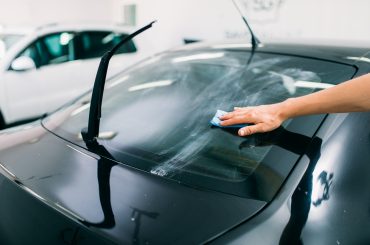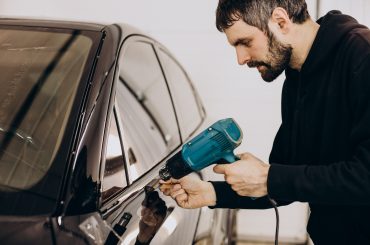Does window tinting reduce heat inside our cars? Read this article to learn all about window tinting and how it affects the temperature inside your car.
The rapidly increasing global warming condition is also a result of the same IR radiation that causes heat inside your car. Due to the depletion of the ozone layer, IR rays enter the atmosphere. When they strike the earth and reflect back, they cannot radiate back to space and get trapped. Thus, the energy of these rays generates heat inside the atmosphere. This is known as the greenhouse effect. The same effect will occur if you do not use a good heat-blocking tint.
So let’s identify the effects of high heat generation inside your vehicle and the negative impacts on your health and car.
Table of Contents
Why You Should Go For a Heat Blocking Tint
You must have briefly encountered an idea about this in our article Regular vs Ceramic Window Tint. We have discussed the health effects of getting into heated cars in the chapter Why You Should Care About Reducing Interior Heat So, let’s identify the reasons that you should go for a heat blocking tint, in order to reduce the heat inside your car.
It is true that seasons change and the sun glare increases and decreases accordingly. So during days of the scorching sun, a car would get heated up so fast into dangerous levels. The main reason for this is the penetration of IR radiation into the car through windows. When the IR rays get trapped inside the vehicle, heat generation occurs. This can happen even if the car is parked in the shade on a sunny day. Thus, it is clear that this heat generation can be eliminated if the IR rays can be blocked and kept away from reaching your interior.
Does Window Tinting Reduce Heat?
The answer is yes, window tinting reduces heat due to the reduction of thermal rays, but the amount of heat reduction would depend on the type of window tint. It definitely helps your car be cooler even though the shade is not always dark. There would be certain glasses that would not block thermal rays even though they are dark. Refer more about these on Privacy Glass.
How Does Tinting Windows Keep Car Cooler?
The window tint acts as a barrier between the sun and the film coating of tint. The colored dye, the metal fragments, or the nanoparticles present on the tint film blocks the heat-generating IR rays from entering the vehicle. It only allows some selected rays that are responsible only for the light energy transmission. Therefore, some amount of light is passed into the car and creates visibility inside. Thus, it is evident that using a good heat locking tint would provide a solution for most of the heat elimination requirements.
The Efficiency of Heat Blocking Tints
The efficiency of heat locking tints will definitely be based on the type of tint and the transmission ratings. The regular dyed tint is the most affordable, but would not provide much heat rejection. It absorbs IR radiation onto the film and also refrains it from traveling into the vehicle. Due to this mechanism, the ability of heat resistance is low since no film can completely absorb all the radiation.
The carbon window tint reflects IR radiation and provides a heat reduction of up to 40%. The ceramic window tint has an efficiency that could block radiation to create up to 80% heat reduction. This is the most beneficial type that could provide good interior cooling with a temperature drop of many degrees Celsius.
What is the Best Type?
The most effective type that blocks off harmful radiation is the ceramic window tint. It is the most technologically advanced type and also the most expensive. The best idea would be to research all these varieties and choose the best type for your requirements. In order to identify the types, and learn more about them, refer to our article on Types of Window Tint.
When Should You Tint Your Windows?
If you are looking forward to tinting your car windows to get heat reduced completely and keep the interior cool, then refer to more details on How to Tint Car Windows.
Make sure to tint your car windows at the best time, to ensure the quality of the work. You can learn more about this on How Long Does it Take to Tint Car Windows. It includes a detailed description of the ideal environmental conditions for tinting.
After you tint your car windows, do not forget to follow the tips on Window Tinting Aftercare.
Do Darker Shade Cars Trap More Heat?
This is one of the most frequently asked questions and is ignored as a myth by some people. The truth is; yes, the darker paint colors such as black colored cars would absorb more heat than the lighter colors. Therefore, even when parked in similar conditions, the light-colored car would have the advantage of getting less heated than the dark-colored cars. Even if you have a dark-colored car, you can reduce the heat impact by installing a proper heat-blocking tint. The following tips might also be useful for you.
Tips and Hacks for Keeping Your Car Cool
- Park in the shade as much as possible during hot weather.
- Use a windshield screen or a dash cover to block out some radiation during parking.
- Use a remote start so that the air conditioning system is turned on before opening the door.
- Cover the steering wheel using a hand towel to reduce temperature.
- If you leave your possessions inside the car, make sure to cover them with a cloth.
- Park in a temperature-regulated interior when possible.
- Use a solar-powered fan that would create constant air circulation within the car when windows are opened.
- Put some blankets over your seats when parking in the sun. Leather and vinyl are mostly used in car seats and would easily get heated up. Using a cloth to cover them, the heat absorption can be reduced.
- Leave the car doors open for some time before getting into a hot car. This would let cool air enter the car and lessen the heat inside.








